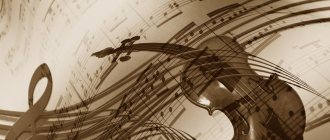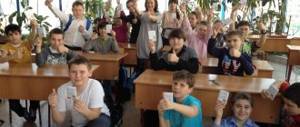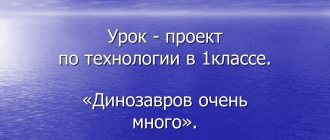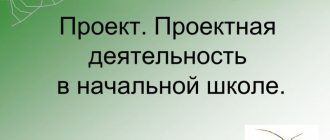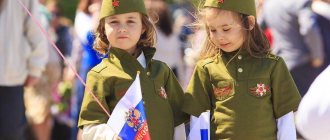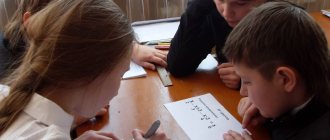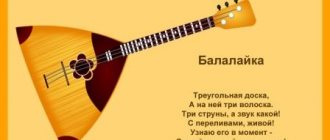Lesson - general characteristics
In a general pedagogical sense, forms of organization (organizational forms) of teaching are understood as the external expression of the coordinated activities of the teacher and students, carried out in a certain order and mode.
Organizational forms are classified according to various criteria.
For example:
1) by the number of students (mass, collective, group, microgroup, individual forms);
2) at the place of study (school and out-of-school);
3) by duration of classes (classic lesson (45 minutes), paired lesson (90 minutes), paired shortened lesson, lesson of arbitrary duration).
At present, the classroom-based teaching system, which arose in the 18th century, continues to develop (Ya.A. Komensky). Its key component is the lesson.
A lesson is a complete segment (stage, link, element) of the educational process in terms of meaning, time and organization.
A music lesson is the main form of organizing music education at school. Despite the fact that the school conducts extracurricular work on music education (clubs, holidays, extracurricular activities, etc.), the lesson is of paramount importance.
The essence of a music lesson, like any other, is the organization of educational and cognitive activity of students, which should always be emotionally charged. This activity is based on the process of music perception.
The main types of educational musical activities (methods, forms of communication with music) of schoolchildren in the classroom are considered to be listening, playing music (singing, playing elementary musical instruments, plastic intonation, musical-rhythmic movements, creativity (composition and improvisation).
A music lesson should present all components of the educational process: goal, objectives, content, methods, etc.
Common and distinctive features of music lessons and lessons in other subjects. On the one hand, a music lesson is an integral part of the general educational process at school, so it must meet all the necessary requirements for the lesson. On the other hand, a music lesson is an art lesson, as a result of which it has a pronounced originality. In this regard, a music lesson has both common and distinctive features with lessons in other academic subjects, especially the natural science cycle.
Common features:
— the ultimate goal of general education;
— the construction is based on psychological and pedagogical principles;
— reliance on general pedagogical principles;
- the form of the lesson itself with its main features (permanent class composition, mandatory lesson, its duration, forms of work such as communicating something new, consolidating, repeating, checking the mastery of the material, etc.);
— integrity, focus on achieving goals, mastering content, types of educational activities;
— basic teaching methods.
Distinctive features (which give originality and general features):
— the main distinguishing feature of a music lesson is that it is an art lesson, not a scientific discipline. Musical art is a special form of reflection of reality, in which the most important role is played by feelings and the emotional sphere. In this regard, musical knowledge should occur on the basis of the unity of emotions and reason, consciousness and feeling;
- the indispensable unity of the artistic and technical, when the artistic (goal) constantly illuminates the technical (the path to the goal), when work on technology is at the same time work on artistry (expressiveness), imagery;
- advantage in lessons of collective forms of work;
- the main content of any lesson is the music itself, communication with it;
- the creative nature of all types of educational musical activities;
- the advantage of dialogue;
— non-traditional structure of lessons, originality of types;
- reliance on problem-based learning.
Consultation “Modern music lesson”
Ivan Vasiliev
Consultation “Modern music lesson”
Time goes by quickly. One generation quietly replaces another. It's the 21st century - the "age of speed"
,
“age of integration”
,
“age of information”
, age of new technologies, gadgets, the Internet and new progressive youth.
The age of new modern people , whose lives are always on the move.
A person of the 21st century is a person of information who tries to comprehend all spheres of life, strives for freedom, through art reshapes reality, goes beyond boundaries, changes life and achieves harmony and freedom. The main requirement for a modern person who lives in a world of global changes and integration processes, extremely rapid development of technology and information resources, is the ability to create. Therefore, one of the tasks of modern education is to create conditions for the formation of a competent, creative personality. An important place in the process of formation of education belongs to the artistic and aesthetic cycle, which influences the development of the emotionally sensitive sphere of the student. Art is a kind of tuning fork of civilization, a universal way of thinking, capable of synthesizing truth, goodness and beauty, and shaping a creative person. Artistic and aesthetic education is an intermediary between socially significant cultural values and personal values of a person and ensures the formation of basic competencies (general cultural, artistic-cognitive, artistic-communicative, etc., forms the desire and ability for artistic and creative self-realization of spiritual self-improvement throughout life. An important role in all this activity is played by the emotionally sensitive sphere and the creative activity of the individual, the development of which is directly related to art activities.
The main goal of modern music education is: “the establishment of musical culture as an integral part of spiritual culture” (Standard of Basic General Education)
.
The current tasks of modern school music education are:
• development of consciousness, musical thinking of children ;
• development of the emotional sphere of students;
• development of the strong-willed, active side of the personality associated with the development of various types of activities.
Current problems of modern music education are:
• use of an integrated approach to teaching based on the interaction of various types of art;
• introduction of new educational technologies;
• use of innovative forms of work;
• use of modern methods of music education ;
• use of the principles of artistic didactics.
A music lesson is , first of all, a lesson in creativity , and should not only be the fact of a child meeting music , its result should be changes in the child himself. Modern school music lesson : what lesson has the right to be called modern ? In the generally accepted understanding, a modern music lesson is a lesson in tune with the times, in which the priority tasks of the educational sphere and the specifics of music . Today, the tasks of school education are centered around the child, the revelation of his individuality and uniqueness, the ability to find himself in society, to be a transformer of himself and the surrounding reality.
The teacher's goal in a modern school music lesson is focused on the changes occurring in students. This means that the learning process should not be aimed at transferring ready-made experience of musical activity , but at mastering ways to be involved in this experience, to master, transform and replenish it yourself. The changes that occur in a child are manifested in all components of his musical culture : his musical experience , musical literacy , musical creativity . The formation of each component of musical culture is the subject of the pedagogical activity of a music . The high-quality implementation of the state standard of general education is facilitated by the introduction of new educational technologies.
The concept of “pedagogical technology”
can be considered in three aspects:
• scientific - as a part of pedagogical science, studying and developing the goals, content and methods of teaching and designing pedagogical processes;
• procedural - as a description (algorithm)
process, a set of goals, content, methods and means of achieving the planned learning outcomes;
• activity-based - implementation of technological (pedagogical)
process, the functioning of all personal, instrumental and methodological pedagogical means.
The introduction of new educational technologies is aimed at improving the educational process and developing the artistic and practical competence of students.
The most indicative is the use of innovative technologies: technology of developmental education - problem-based presentation of educational material, partial search activity, independent project research activity.
The implementation of the project method and the research method in practice leads to a change in the teacher’s position. From a carrier of ready-made knowledge, he turns into an organizer of cognitive, research activities of his students. The psychological climate in the classroom is changing, as the teacher has to reorient his work and the work of students to various types of independent activities of students, to the priority of activities of a search, research, and creative nature.
The structure of musical activity contains the following elements: goal - means - process - result. This condition is a guideline for the teacher, allowing him to organize productive musical activities of schoolchildren. Productivity in this case appears not only as the result of a creative act, represented in the creation of something new and original, but, first of all, as the quality of students’ activity.
At all times music as a powerful psychological force to influence the feelings and will of people. This energetic potential of music is also successfully used by modern show business , which, with the help of musical products, has formed not only “tastes”, but also a persistent reluctance of young people to notice the greatest wealth of high art in general. musical training and education in secondary schools becomes particularly relevant
A lesson is often an inconspicuously intense work that requires enormous effort from the teacher, maximum concentration, flexible thinking and instant reaction in all sorts of psychological situations.
Music lessons have a particularly emotional atmosphere, and this is quite normal, since music is the language of feelings . It moves and excites the feelings of schoolchildren, creating certain moods, ultimately influencing the behavior and relationships of students.
A music lesson aims the teacher at nurturing musical culture in schoolchildren as part of their general spiritual culture. With this setting of the goal of musical education, it is especially important to master the art of your profession. “There is art and there is creativity,” said V. Nemirovich-Danchenko. This opposition is not accidental. It naturally arises when we are talking not about external, but about deep creative processes in art. Thus, a creative music lesson becomes a comparison to another lesson , in which craft reigns, even the most skillful one. In this regard, the problem of “external” and “internal” in the art of conducting a music lesson . It’s one thing if the lesson is just the introduction of some new auditory additions to the musical impressions of schoolchildren. It’s another matter if this is a special, unique encounter with art. The problem of “external” and “internal” in music lessons is , in fact, the real relationship between music as an art and the art of conducting a music lesson . While studying music in such lessons , children will have to feel that they are studying life, that music is life itself .
Types of Music Lessons
By type, it is generally accepted to understand the form, appearance of something, which has significant qualitative characteristics. In this case, the type of lesson is determined by the presence and sequence of its structural parts. The types of music lessons are varied and differ significantly from the types of lessons in natural science disciplines (lessons of learning new knowledge, developing new skills, generalizing and systematizing what has been learned, monitoring and correcting knowledge and skills, practical application of knowledge and skills, combined (mixed) types).
Types of music lessons usually have a non-traditional structure, that is, they are non-standard. This is due to the fact that the key problem of music education is creating an atmosphere of interest and passion in the classroom; the purpose of non-standard lessons is precisely to arouse and maintain the interest of schoolchildren in educational work.
Common types of music lessons include the following: image lesson, press conference, competition, dramatized lesson, student-led lesson, creativity, competition, quiz, game, music collection, concert, integrated lesson, crossword lesson, music program, music salon and etc.
Obviously, the category of non-standard lessons includes those types that usually appear as auxiliary, extracurricular and extracurricular organizational forms. Of course, these types of lessons are interesting, unusual, and students really like them. At the same time, experts believe that turning them into the main form of work is inappropriate due to a large loss of time, lack of serious cognitive work, low productivity, etc.
The traditional combined type is also quite acceptable for music lessons, which can be structured, for example, like this: organizational moment - repeated study - learning something new, developing new skills - consolidation, systematization - homework. However, due to the specifics of a music lesson, structural components can be moved and also be colored in a unique way.
The thematic structure of the program by D.B. Kabalevsky determined such types of lessons as:
- lesson introduction to the topic;
- lesson on deepening the topic;
- lesson on generalizing the topic;
— a general lesson-concert of the year.
Lesson introduction to the topic. Its main feature is the presence in the content of the initial generalized characteristics of new key knowledge. There is one lesson of this type in each quarter.
The process of introducing a topic in a lesson usually consists of three main points:
1) activation of previously accumulated life and musical experience of students from the perspective of new key knowledge;
2) the very introduction to the topic, which occurs on the basis of creating a search situation;
3) the initial generalized idea of new knowledge is consolidated during the perception of the musical material of the lesson.
Lesson to deepen the topic. The main feature is the presence in its content of a new characteristic of key knowledge. The majority of lessons of this type are in each quarter.
The process of deepening a topic usually consists of three main points:
1) activation of the existing life and musical experience of students (primarily the knowledge that was acquired in this quarter);
2) the actual deepening of the topic (based on the perception of music, the active participation of schoolchildren in the process of cognition, using a variety of means and teaching techniques);
3) consolidating a new quality of understanding of the topic in the process of perceiving various works, using various forms and types of musical educational activities of schoolchildren).
Lesson on generalizing the topic. The main feature is the presence in its content of a holistic, but already enriched, in comparison with the lesson of introduction to the topic, characteristics of key knowledge.
The teacher determines the content of the musical material, selects teaching tools and techniques depending on how the students in a particular class have mastered the topic of the quarter.
The final lesson-concert of the year. The purpose of such a lesson is to demonstrate the level of musical culture of students achieved during the school year.
During this type of lesson, first of all, it is necessary to show:
- how much the children’s interest in music and emotional attitude towards it have increased, how the sense of the connection between music and life has deepened, how an understanding of the moral value of art and emotional attitude towards it have been formed;
— to what extent has the thematic content of the program been mastered, the ability to think about it (a conscious attitude towards music);
— in what way and to what extent the experience of creative educational musical activity is manifested in schoolchildren.
The lesson-concert should be held in a solemn atmosphere. It is possible to combine several classes of one parallel.
A music lesson is an art lesson, therefore its distinctive feature is its creative nature. In this regard, the leading type of music lessons is N.A. Terentyeva considers the lesson to be a creative type.
To build it, according to the author, it is necessary to rely on a number of relevant principles:
— focus on nurturing the child’s emotional culture;
— focus on the formation of imaginative thinking as the most important factor in the artistic development of life;
- creating an atmosphere of creativity, interest, and ease in the classroom as the most important psychological factor guiding the process of artistic discovery;
— developing improvisation skills as the basis for the formation of an artistic and original attitude towards the world around us;
— optimization of the ability of artistic synthesis as a condition for the plastic-sensual and aesthetically multifaceted development of the phenomena of reality;
— development of artistic generalization skills as the basis for a holistic perception of art;
— creation of aesthetic situations as the most important condition for the emergence of an emotional and creative experience of reality;
— formation in schoolchildren of the foundations of artistic knowledge as a necessary prerequisite for the realization of the students’ own creative experience and the development of spiritual criteria for understanding the phenomena of reality.
The leading type of modern music lesson as an art lesson is an image lesson. The following requirements are put forward to him:
— the integrity of the lesson based on an artistic idea, a unified dramaturgy, thematic and intonation connections;
— justification of logical connections, contrasts, comparisons;
- artistic form of the lesson structure (forms of the structure of musical works (1-part, 2-part, 3-part, rondo, variations, sonata allegro, improvisation, fantasy, etc.), form of the structure of a literary work);
— unity of the educational process, the inseparability of ethical, aesthetic and educational tasks with an emphasis on the culture of feelings;
— creating an environment for contemplation, dialogue, and exchange of impressions;
— structuring the material according to the principle of mutual complementarity, facilitating a comprehensive vision of the problem;
— reliance on methods of artistic didactics (pedagogy of art);
- creating an intonational atmosphere of the lesson both in the area of conducting the lesson, creating trusting relationships, and in the nature of interaction with works of art and their authors;
— an active and practical approach to each topic and to the study of lesson elements (reliance on the mechanism of synesthesia).
One music lesson can combine several types, for example, a lesson on deepening a topic can simultaneously contain signs of an image lesson and a travel lesson, an introduction lesson to a topic can be both a creativity lesson and an image lesson, etc.
Self-analysis of a music lesson in 4th grade on the topic “Music of Italy”
1. Lesson Introduction
The lesson was taught in grade 4 “_” (educational organization) in __________. There are __ people in the class – __ girls and ___ boys. Level of learning: at the reproductive level - __ person, at the constructive level - __, at the creative level - __. Level of training: high – __person, medium – __person, low – __person.
Theme of the year for this class: Music of the peoples of the world. This lesson is the first on the topic “Music of Italy”. It has medium difficulty: despite the study of musical works of other countries and peoples, the music of Italy has its own specific characteristics.
Lesson topic: Music of Italy.
The didactic goal of the lesson is to create conditions for understanding and comprehending a block of new educational information.
Lesson type: lesson on studying and initially consolidating new educational material.
Content goals were set for students.
- Educational: to promote familiarization with the musical culture of Italy, to introduce the terms “barcarolle”, “treble”.
- Developmental: continue to develop the ability to listen and analyze musical works, compare the melody of different countries, develop the ability to control the breathing process, and help broaden the horizons of students.
- Educational: to cultivate respect for the culture of other peoples, a sense of patriotism.
Methods: reproductive, explanatory-illustrative, partially search.
Forms of organization of cognitive activity: frontal, paired.
Teaching aids: multimedia presentation “Music of Italy”, cards for students “Call a Friend”, piano, lyrics of the song “Bella Ciao”.
2. Didactic lesson analysis
The didactic goal of the lesson determined the logic of the lesson, as well as the nature of the interaction between the teacher and students.
The educational goal of the lesson passed through the content of the educational material. Work on introducing the music of Italy was carried out at all stages of the lesson - actualization, motivation and goal setting, primary study of educational material, awareness and comprehension of the material. Work on familiarization with new terms was carried out during the study of new material.
During the lesson, work was carried out to develop the ability to compare the melodic music of different countries at the stage of learning new material.
The logic of studying educational material determined the change in types of activities and forms of organization of cognitive activity: frontal - at most stages of the lesson, pair - at one of the stages of the lesson. The selected FOPD ensure cooperation between the teacher and students, contribute to the inclusion of each student in activities to achieve the set goal.
The selected lesson methods correspond to the level of ability of this class. The partial search method, used at the initial stages of the lesson and in the process of learning new material, contributes to the development of motivation to study new material; the use of the explanatory and illustrative method is due to the fact that the proposed material is unknown to students; the reproductive method contributes to more solid assimilation. The selected methods ensure the assimilation of theoretical knowledge and the development of the emotional-volitional sphere of students.
The means, including information technologies, used in the lesson ensured the development of cognitive interest.
During the lesson, interdisciplinary connections were made: music - history, music - MHC, which also contributes to the development of cognitive interest and motivational sphere of students.
To achieve the developmental goal of the lesson, a conversation was used, which made it possible to organize work on the development of students' oral speech, vocal pedagogy techniques that contributed to the establishment of correct singing breathing. The health-saving technologies used in the lesson are innovative; the proposed techniques can be used in every music lesson, which ultimately leads to improved health of students.
The achievement of the set educational goals was facilitated by the content of the lesson, the chosen forms of organizing cognitive activity at the stages of learning new material and in the course of awareness and comprehension.
3. Real result of the lesson. I believe that the goal set for the lesson was achieved.
4. Conclusion on the lesson. The achievement of the goal was facilitated by the selection of content, type of lesson, FOPD, methods, means, techniques. During the lesson, changes were made to the planned stages of the lesson related to (circumstances and reasons for the changes).
5. Lesson reserves.
For the full text of the material Self-analysis of a music lesson in 4th grade on the topic “Music of Italy”, see the downloadable file
. The page contains a fragment.
| Author: Yulia Petrovna Biserova → Publisher 09/30/2015 0 10314 658 | Comment |
Thank you for your mark. If you want your name to be known to the author, log in to the site as a user and click Thank you again. Your name will appear on this page.
Login | Registration
Have an opinion? Leave a comment
Extracurricular work on musical education of schoolchildren
Along with the main form of musical education for schoolchildren (lessons), there is extracurricular work on music education. The variety of forms of its organization is due to the creative initiative of the music teacher, the organizer of extracurricular activities at the school, and the attitude of the administration.
Objectives of extracurricular work in music.
Participation in extracurricular activities opens up the opportunity for schoolchildren to engage in depth with what interests them, and hence a more intensive development of love and interest in music in general, and the acquisition of new knowledge and skills. Children can see from personal experience that school music lessons are closely related to life, since the knowledge, skills and abilities they acquire in music lessons are actively in demand outside of class. During extracurricular activities, the teacher has the opportunity to further introduce interested children to music and systematically shape their creative activity.
When organizing extracurricular work in music, the teacher must do the following:
— all types of extracurricular musical activities should be aimed at the moral and aesthetic education of schoolchildren, the formation of their musical tastes and interests:
- the widespread use of methods should contribute to the awakening of artistic needs, the development of artistic imagination, musical and creative abilities of students;
— it is necessary to cultivate in schoolchildren an interest in educational work and a desire to promote musical culture;
— The success of all the various work on musical education is largely determined by the extent to which the children master various types of musical activities and feel the need for it; - in each specific case, it is necessary to take into account the fact that the formation of the interests and tastes of children is greatly influenced by the media, peers, and family.
Extracurricular musical and educational work is carried out in two main directions: circle forms and mass forms.
Circle shapes.
These include: choral, vocal, orchestral, dance, instrumental, vocal-instrumental, folklore and other clubs. This also includes musical theater.
Joining a particular circle is determined mainly by the desire of the participants. At the same time, a certain level of development of relevant musical abilities is also required, which, of course, is lower than in special music schools and studios.
Practice shows that every normal healthy child, if he is interested in activities, can develop all musical abilities, including a singing voice, a sense of rhythm, and even an ear for music.
Choir clubs unite students by age: junior schoolchildren (grades 1-4), middle school students and high school students (9-11). The creation of a school-wide choir that unites all groups to perform a pre-planned piece is of great educational importance.
As a rule, the choir consists of 25 to 80 people. The duration of the lesson depends on the age of the participants (from 45 to 90 minutes). Each lesson is planned, and the teacher tries to make it interesting and varied.
The teacher’s knowledge of the physiological characteristics of the formation of the children’s vocal apparatus is of great importance. The repertoire for classes also requires careful selection.
Musical instrument learning clubs. Classes are conducted individually, which contributes to the active development of musical abilities, cultivates musical taste and interest in music. The main thing is that such classes are not limited to the technical mastery of a certain repertoire and mastery of a set of skills. An important factor is the organization of concert performances by circle participants.
Children's folklore ensemble. Its creation requires the teacher to have knowledge of folk art, the richness of its genres and regional characteristics.
Already at the age of 7, children enjoy singing songs, nursery rhymes, and jokes. The ensemble's repertoire includes folk songs that are accessible to children, characteristic of a particular region, as well as original compositions that embody vibrant folk traditions. They must be accessible for children to perform, understandable in content, and arouse interest. For example, specially prepared (possibly hand-made) folk costumes, as well as simple musical instruments (spoons, rattles, etc.) play a big role in children’s interest in folklore.
School orchestra or folk instrument ensemble. Unfortunately, there are few such groups, but experience shows that they are capable of playing an important role in promoting musical culture. Thanks to the design features of Russian folk instruments, it is possible to master them quite quickly and at the same time actively develop the musical abilities of students. Even people with limited musical abilities can play a musical instrument quite successfully. Participants are trained in a preparatory group. When assigning instruments, it is necessary to take into account the physical and musical characteristics of each student, and, of course, desire.
Vocal and instrumental ensemble. This is the most popular circle among children and teenagers, as they have a pronounced desire and desire to follow fashion and through this establish themselves among their peers. In addition, popular music is accessible to perception and attracts with its external simplicity and brightness. Participants in such an ensemble are often captivated by the process of playing rather than by the artistic merits of the works, which negatively affects the formation of taste, and interests are limited only to imitation of popular rock bands.
At the same time, interest in modern light music can also be used to introduce teenagers to musical culture. To do this, their repertoire includes folk songs, instrumental pieces, and sometimes transcriptions of classical works. Thus, exposure to the best examples of musical art has an educational effect on adolescents (especially “difficult ones”), and solving educational problems contributes to their spiritual growth.
School musical theater. Its work can involve a wide range of students with different interests, since staging an opera performance requires soloists, a choir, dance groups, participants in crowd scenes, artists, decorators, lighting technicians, make-up artists and costume designers. Each participant in the production of the play, doing what they love, at the same time gets involved in the art of music.
The theater director needs to carefully consider the repertoire, as well as how to present the work to children (a fascinating story about the content, history of creation, authors, and after listening - a conversation about the musical characteristics of the characters). The idea of opera can be helped to understand by analyzing the means of musical expression and memorizing the main melodies. The selection of performers and understudies should be accompanied by discussion in the team and accompanied by explanations from the manager. The selection of costumes and decorations can be carried out on the basis of a competition of sketches developed by children. Parents and older schoolchildren can be involved in their production. Next, each number is rehearsed separately, and then rehearsals are held as a whole. The final stage is the preparation of colorful posters.
It is very important that participation in opera performances develops children’s creative abilities, their fantasy and imagination. Such a theater can become the center of broad and effective educational work through the means of art. It is gradually forming a permanent composition, which is replenished with new members. It is possible to attract schoolchildren from other clubs to participate in the performance.
Thus, music clubs create great opportunities for the manifestation of inclinations and the development of musical and creative abilities of students. By expanding the scope of the lesson, they are important in nurturing the interests and tastes of schoolchildren.
